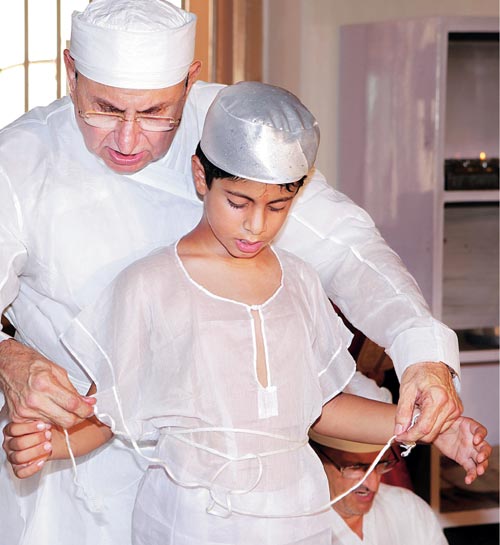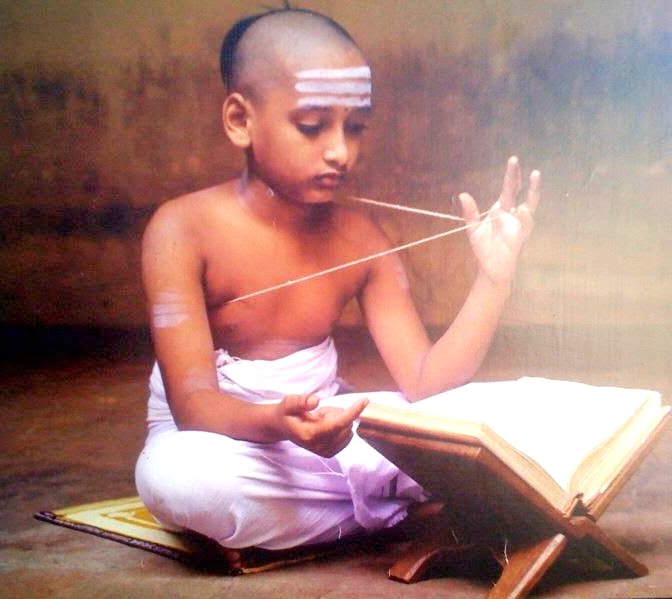
| KUSTI AND YAGNOPAVIT The Kusti ritual :
The
following account is that of Dastur Jamaspji Minochiharji Jamasp-Asa-na,
as recorded by E. W. West, SBE 18, pg 383 ff.
Kusti
ritual part 1 -- tying the kusti :
Holding the Kusti in this fashion, the person recites the following prayer in Pazand, bowing and raising to his forehead the horizontal portion of the string at the name of Ohrmazd*, dashing the string loosely and sharply downwards towards the left when mentioning Ahriman**, and repeating this downward jerk to the left, less violently, as each of the other evil beings+ is named :
hôrmezd* i hvadâe, âharman** awâdishâhã dûr awâzh dâshtâr zat shkasta bât. âharman** dêwã+ drûzhã+ jâdvã+ darvañdã+ kîkã+ karafã+ sâstârã+ gunâhkârã+ âshmôgã+ darvañdã+ dushmanã+ faryã+ zat shkasta bât. dushpâdishâhã+ awâdishâhã bât, dushmanã+ stuh bât, dushmanã+ awâdishâhã bât.
(Ohrmazd is Lord! Ahriman he keeps at bay, he holds him back. May Ahriman be struck and defeated, with devs and drujs, sorcerers and sinners, kayags and karbs, tyrants, wrongdoers and heretics, sinners, enemies and witches! May they (all) be struck and defeated! May evil rulers not exist, (or) be far away! May enemies be defeated! May enemies all not exist, (or) be far away!)
Bending forwards and holding the doubled Kusti up, horizontally, as before, we continue :
hôrmezd i hvadâe, ezh hamâ gunâh patit pashêmãnôm, ezh haravistîn dushmat duzhûxt duzhvaresht men pa gêthî minît vaem guft vaem kard vaem jast vaem bun bût estet.
(O Ohrmazd, Lord! I am contrite for all sins and I desist from them, from all bad thoughts, bad words and bad acts which I have thought, spoken or done in the world, or which have happened through me, or have originated with me.)
Then, holding the Kusti single with both hands near the middle of the string, but as far apart as before, while the loose ends of the string are shortened (to prevent their touching the ground) by being partially gathered, up in a large loop kanging under each hand, like a pair of spectacles, he proceeds :
ezh ã gunâhihâ manishnî gaweshnî kunishnî tanî rvãnî gêthî mainyuãnî ôxe awaxsh pashêmã pa se gaweshnî pa patit hôm!
(For those sins of thinking, speaking and acting, of body and soul,
worldly or spiritual, O Ohrmazd! I am contrite, I renounce them.
With three words I distance myself from them.)
xshnaothrâ ahurahe mazdå (With satisfaction for Ahura Mazda)
bowing and raising the Kusti to the forehead;
tarôidîti angrahe mainyêush, (scorn for Angra Mainyu!)
jerking the Kusti to the left, without altering the mode of holding it;
haithyâvarshtãm hyat vasnâ ferashôtemem. staomi ashem,
ashem vohû*....
(The true achievement of what is most wonderful, according to wish! I praise Asha! Ashem Vohu....)
Applying the middle of the Kusti to the front of the waist at the first word, 'Ashem* (righteousness),' of the last sentence, it is passed twice round the waist during the remainder of the sentence, by the hands meeting behind, exchanging ends, and bringing them round again to the front.
The following Avesta formula is then recited :
ýathâ ahû vairyô
athâ ratush ashâtcît hacâ
vanghêush dazdâ mananghô
shyaothananãm* anghêush mazdâi
xshathremcâ ahurâi â
ýim drigubyô dadat vâstârem!!
(As a patron spirit is to be chosen, so is an earthly master, for the sake of righteousness [Asha], to be a giver of good thought of the actions of life towards Mazda; and the dominion is for the Lord [Ahura] whom he has given as a protector for the poor.)
At the first word the long ends of the Kusti, hanging in front, are loosely twisted round each other at the waist, with a right-handed turn (that is, with the sun), and the reciter, holding his hands together, should think that Ahura Mazda is the sole creator of the good creation, until he comes to the word 'shyaothananãm/actions,*' after which the twist is drawn closer to the waist during the remainder of the recitation.
The same Avesta formula is then repeated. At the first word the second half of the knot is formed, by twisting the long ends of the Kusti loosely round each other with a left-handed turn (that is, against the sun), so as to complete a loose reef-knot, and the reciter, holding his hands together, should think that Mazda-worship is the true faith, until he comes to the word 'shyaothananãm/actions,' after which the complete double knot is drawn close during the remainder of the recitation.
Then, passing the long ends of the Kusti round the waist for the third time, from front to back, the previous Avesta formula, 'Righteousness is the best good,' &c., is recited.
ashem vohû....
At the first word the ends of the Kusti are loosely twisted round each other behind the waist, with a right-handed turn as before, and the reciter should think that Zarathushtra was the true apostle, until he comes to the first occurrence of the word 'blessing,' when the twist is drawn close. During the remainder of the formula the second half of the knot is formed, with a left-handed twist as before, while the reciter thinks that he must practise good thoughts, good words? and good deeds, and avoid all evil thoughts, evil words, and evil deeds; the double knot being completed behind as the last word of the formula is uttered.
Kusti part 2: The Zoroastrian Creed :
Afterwards, bending forward and holding the front knot of the Kusti with both hands, the person recites the following Avesta formula : jasa-mê avanghe mazda (3).
mazdayasnô ahmî mazdayasnô zarathushtrish fravarânê âstûtascâ fravaretascâ, âstuyê humatem manô âstuyê hûxtem vacô âstuyê hvarshtem shyaothanem. âstuyê daênãm [vanguhîm] mâzdayasnîm fraspâyaoxedhrãm nidhâsnaithishem hvaêtvadathãm ashaonîm ýâ hâitinãmcâ bûshyeiñtinãmcâ mazishtâcâ vahishtâcâ sraêshtâcâ ýâ âhûirish zarathushtrish, ahurâi mazdâi vîspâ vohû cinahmî. aêshâ astî daênayå mâzdayasnôish âstûitish!!
(Come to my aid, O Mazda (3).
I profess myself a Mazda-worshipper, a Zoroastrian, having vowed it and professed it. I pledge myself to the well-thought thought, I pledge myself to the well-spoken word, I pledge myself to the well-done action. I pledge myself to the Mazdayasnian religion, which causes the attack to be put off and weapons put down; which upholds khvaetvadatha, which possesses Asha; which of all religions that exist or shall be, is the greatest, the best, and the most beautiful: Ahuric, Zoroastrian. I ascribe all good to Ahura Mazda. This is the creed of the Mazdayasnian religion.
And the reciter then repeats the formula, 'Righteousness is the best good,' etc., as before, bowing reverently, which completes the rite.
ashem vohû....
The sacred white thread also known as Janaeu is a thin cord, donned by Brahmin boys after they reach the age of 12. Wearing the Janeu is part of their 16 Sanskaar as prescribed by Hinduism. The janeu is worn during an Upanayan Sanskar and is the 10th Sanskaar of the Santana Dharma of the Hindu religion. The Janaeu is regarded as a symbol of the sacred vision to see things in a just way. Lets explore the science behind sacred thread Janaeu.
A
lot of people are unaware of the science and the benefits of wearing
this sacred thread. Let’s have a look at some of them :
The Gayatri mantra is chanted before wearing the thread, the Gayatri mantra is as follows :
tat-savitur varenyam
bhargo devasya dhimahi
dhiyo yo nah pracodayat ||
It is one’s prime responsibility to keep the sacred thread clean and sanitary.
Along with Brahmins Janev also worn by Kshatriyas (warriors). |

